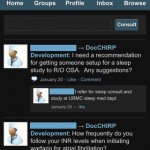 Few industries have taken to crowdsourcing with quite the enthusiasm as the healthcare industry. A recent paper by Mike Weiner, director of the Regenstrief Institute’s Center for Health Services Research. The paper provides an overview of the primary uses of crowdsourcing in healthcare today:
Few industries have taken to crowdsourcing with quite the enthusiasm as the healthcare industry. A recent paper by Mike Weiner, director of the Regenstrief Institute’s Center for Health Services Research. The paper provides an overview of the primary uses of crowdsourcing in healthcare today:
- Crowd labour, where people are recruited to perform particular tasks
- Creative crowdsourcing, which is similar in many ways to crowd labour, but focuses on innovative tasks
- Crowd research, which is broadly speaking the citizen science applications
- Crowd funding, which I’m sure you’re all too familiar with already
The mobile application DocCHIRP takes a slightly different approach. The app aimed to help medical providers quickly close any knowledge gaps that may exist in day to day operation by letting healthcare professionals network and knowledge share via real-time information requests.
The app was originally trialled over a 244 day period to staff from the University of Rochester, and the academics that produced the application have documented their findings in a recent paper. The report reveals that the vast majority of DocCHIRP users were practicing physicians, with nurse practitioners making up the remainder.
It’s difficult to gauge the success of the application in a pure form due to the relatively small sample of users trying it out. The paper reveals that just 45 questions were generated during the trial period, or one every 5 days. This rather pales into comparison with other, similar, services, such as the Doximity social network that I wrote about recently, which already claims to have nearly 50% of all physicians in the United States signed up. Obviously those sites were open to all, so it is perhaps an unfair comparison, but nevertheless a small, closed test can often restrict the speed and scope of learning available.
Nevertheless, the researchers sought to delve deeper into usage of the application and understand more about those that used it. For instance, it emerged that there was a degree of reluctance to use the application, for fear that it would expose gaps in the knowledge of those posing the questions. This resulted in a request that anonymous posting be offered, to overcome the potential for embarrassment.
Participants also raised the spectre of doctors becoming distracted by such applications, although they believed such risks would easily be countered by the increased productivity the applications would afford them.